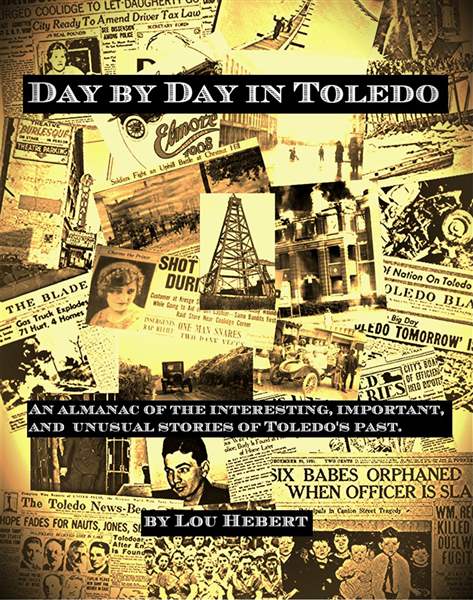
Local author chronicles Toledo’s history, day by day
12/17/2013
Cover of 'Day by Day in Toledo: An Almanac of the Interesting, Important, and Unusual stories of Toledo's Past,' by Lou Hebert.

Hebert
Toledo has been the site of some remarkable events through the decades. Why, did you know that the man who hurled Bozo the Clown to American icon status was born here on Jan. 2, 1925? And did you know that only nine out of 82 men who applied to become Toledo firemen were accepted on April 7, 1905? The others were rejected because they had bad noses, bad teeth, or a husky voice.
Those tidbits and more are chronicled in a 258-page book titled Day by Day in Toledo — An Almanac of the Interesting, Important, and Unusual Stories of Toledo’s Past. It’s the conclusion of years of collecting and researching such snippets by the widely known Lou Hebert, whose familiar voice has been heard for decades as a reporter and news director on “a number of radio and television stations here in town,” as he put it.
Just choose any one of 365 days of the year and you can find in the book information that ranges from the mundane to the astonishing. Born on Leap Year’s Feb. 29? That’s not overlooked, as Mr. Hebert includes that day too. The paperback, available for $22 at the Toledo Police History Museum at 2201 Kenwood Blvd., and on Amazon and ebay, tells the short version of a few or several events that happened on every day of 12 months of the year in and around Toledo.
Mr. Hebert, a Toledo native who was reared in Genoa, got the idea to keep a list of events that occurred on a particular day about 40 years ago while working at the former radio station WOHO.
“I was doing news back then in about 1973,” he said. “I thought it would be neat to know what things happened in Toledo on a specific day, and I started casually keeping a calendar. I would jot things down for my own use and I kept it up over the years.”
About a decade ago, he decided his loosely kept project was interesting after all. That decision compelled him to research history and library books and to garner more information from The Blade and the News Bee.
Describing himself as semi-retired now, Mr. Hebert does the morning news for country radio station WPFX, 107.7 FM. A board member at the police history museum, he said he put in some 4,000 hours of research.
“It was close to two years, I would imagine,” he said about work for the book, which consumed him morning, noon, and night the last couple of years. “And before the Internet, it was a lot of leg work and that required a lot of time and effort.”

Cover of 'Day by Day in Toledo: An Almanac of the Interesting, Important, and Unusual stories of Toledo's Past,' by Lou Hebert.
Mr. Hebert expects a cross section of people will be interested in his book. It includes news of the day, both tragic and amusing, and there’s insight into family life as well as some mysterious happenings. Local history buffs are bound to want to read it, as might most who will want it among the family’s books.
“As I began to put it together, there was so much I learned about Toledo,” Mr. Hebert said. “There are so many other facets to Toledo’s past that one of the things I tried to do was to capture those to give people bit-sized information to inspire them to go look up more about something. That was my intent.”
Here are some other highlights that come directly from Day by Day in Toledo.
Feb. 1, 1907: Controversy is raised over news that President Theodore Roosevelt has suggested that a “colored man” be appointed to a key federal post for Toledo.
March 26, 1923: News Bee reports that many Toledoans are getting baby alligators from friends and family who have been vacationing in Florida.
May 24, 1854: Toledo council votes to hire “night watchmen” at $1.25 a night.
June 11, 1897: Owney, the world famous traveling U.S. Postal dog, was shot and killed in Toledo by police after reportedly biting a postal clerk. The beloved animal was mounted and stuffed the next day by a Toledo taxidermist and sent to Washington, where it remains on display at the Smithsonian Institute.
July 3, 1817: Sea serpent reported by early settlers and explorers near Middle Bass Island.
Aug. 20, 1879: Reunion of the Civil War’s Storming of Selma by the 3rd Ohio Volunteer Cavalry held in Toledo.
Sept. 5, 1865: Wooden span of the Cherry Street Bridge is opened to traffic with new drawbridge.
Oct., 17, 1921: Large throng of men jam third floor of Toledo City Hall to apply for 200 temporary jobs with the city. Two of the men collapse in line from hunger.
Nov. 4, 1960: U.S. Senator John F. Kennedy visits Toledo for campaign rally. About 25,000 people gather at Lucas County Courthouse to hear Kennedy speak.
Dec. 31, 1949: The last trolley car runs on the streets of Toledo as the Monroe Street longbelt streetcar makes its final run. Hundreds turn out to watch the trolly on its end-of-the-line trek through downtown Toledo.